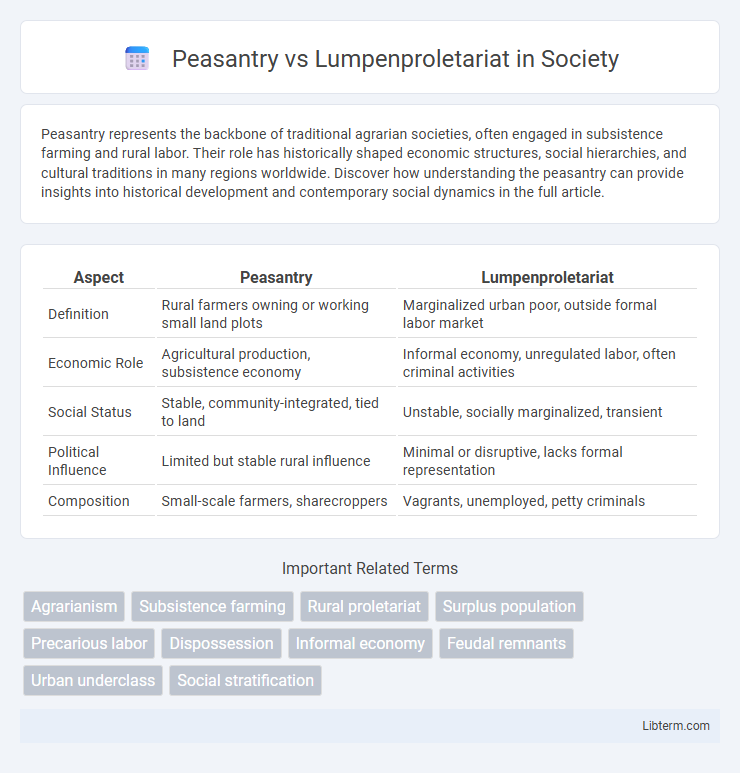Peasantry represents the backbone of traditional agrarian societies, often engaged in subsistence farming and rural labor. Their role has historically shaped economic structures, social hierarchies, and cultural traditions in many regions worldwide. Discover how understanding the peasantry can provide insights into historical development and contemporary social dynamics in the full article.
Table of Comparison
| Aspect | Peasantry | Lumpenproletariat |
|---|---|---|
| Definition | Rural farmers owning or working small land plots | Marginalized urban poor, outside formal labor market |
| Economic Role | Agricultural production, subsistence economy | Informal economy, unregulated labor, often criminal activities |
| Social Status | Stable, community-integrated, tied to land | Unstable, socially marginalized, transient |
| Political Influence | Limited but stable rural influence | Minimal or disruptive, lacks formal representation |
| Composition | Small-scale farmers, sharecroppers | Vagrants, unemployed, petty criminals |
Understanding Peasantry: Definition and Historical Context
Peasantry refers to a class of small-scale farmers and agricultural laborers who traditionally cultivate their own land or work on others' farms, forming the backbone of agrarian economies throughout history. Historically, peasants have held a semi-autonomous social position, often tied to feudal or colonial systems, characterized by subsistence farming, communal life, and limited access to industrial or urban labor markets. Understanding peasantry involves analyzing their socio-economic conditions, modes of production, and roles in revolutionary movements, contrasting sharply with the lumpenproletariat, which comprises disenfranchised urban poor disconnected from productive labor.
Lumpenproletariat: Origins and Meanings
The lumpenproletariat refers to the underclass marginalized from formal labor markets, including beggars, criminals, and homeless individuals, often originating from economic displacement, social exclusion, and systemic poverty. Unlike the peasantry, which is tied to agricultural production and rural life, the lumpenproletariat lacks stable employment and class consciousness, frequently viewed in Marxist theory as politically unreliable or reactionary. This group's socio-economic conditions stem from industrialization, urbanization, and the breakdown of traditional social structures, contributing to their precarious, fragmented existence.
Social Structures: Class Positioning and Roles
The peasantry occupies a distinct social class rooted in agrarian production, often characterized by small-scale land ownership or tenancy and direct engagement with agricultural labor. The lumpenproletariat, conversely, comprises marginalized urban populations engaged in irregular or informal economic activities, lacking stable employment or integration into productive capitalist relations. These class positions shape their roles within social structures, with peasants contributing to subsistence and local economies, while lumpenproletariat members typically exist on the social fringes, often excluded from traditional class struggles and organizational frameworks.
Economic Foundations: Means of Subsistence
Peasantry primarily engages in small-scale agriculture, relying on direct cultivation of land to secure subsistence and generate surplus through seasonal cycles. Lumpenproletariat lacks stable access to means of production, often depending on irregular or informal economic activities such as scavenging, petty trade, or casual labor. The economic foundation of peasantry is rooted in tangible land and agrarian resources, whereas lumpenproletariat's subsistence derives from precarious, non-productive engagements outside formal economic systems.
Political Influence and Revolutionary Potential
Peasantry often holds significant political influence due to larger population size and ability to impact agrarian reforms, yet their revolutionary potential is limited by strong ties to traditional structures and land ownership interests. Lumpenproletariat, though lacking political influence because of social marginalization and economic instability, possess high revolutionary potential driven by alienation and willingness to engage in radical actions. Understanding the distinct roles of peasantry and lumpenproletariat clarifies their varied contributions to revolutionary movements and political change.
Cultural Characteristics and Lifestyles
Peasantry typically embodies traditional agricultural lifestyles with strong ties to land, community, and customs rooted in rural economies, emphasizing family labor and local cultural practices. Lumpenproletariat, in contrast, often consists of marginalized urban groups engaged in informal, unstable work or criminal activities, reflecting transient lifestyles and cultural fragmentation. These differences highlight the peasantry's cultural continuity versus the lumpenproletariat's socio-economic dislocation and cultural fluidity.
Relationship with the Bourgeoisie and Capitalist Systems
The peasantry often maintains a semi-autonomous economic position, engaging in small-scale agriculture and occasionally interacting as suppliers or consumers within capitalist markets, which can lead to both cooperation and tension with the bourgeoisie. In contrast, the lumpenproletariat, composed of socially marginalized groups such as unemployed and criminal elements, lacks stable ties to production and is generally excluded from capitalist labor relations, rendering their relationship with the bourgeoisie more antagonistic or peripheral. The bourgeoisie tends to exploit the peasantry through land ownership and market control, while viewing the lumpenproletariat as a destabilizing force that does not contribute productively to the capitalist system.
Intersection with Urbanization and Modernization
The peasantry and lumpenproletariat represent distinct social classes shaped by urbanization and modernization processes. Peasantry, traditionally rural agricultural workers, face displacement and marginalization as urban expansion transforms land use and labor markets. The lumpenproletariat, often composed of marginalized urban dwellers excluded from formal labor, emerge prominently in rapidly modernizing cities where informal economies and social instability proliferate.
Representation in Literature and Media
The portrayal of peasantry in literature and media often emphasizes traditional rural life, agricultural labor, and moral values, reflecting their role as the backbone of early economies and cultural heritage. In contrast, the lumpenproletariat is frequently depicted as marginalized, disorganized, and involved in illicit or underground activities, highlighting social exclusion and instability within urban settings. These representations influence public perceptions by framing peasantry as stable yet oppressed, while the lumpenproletariat is cast as a symbol of social decay and rebellion.
Contemporary Relevance: Peasantry and Lumpenproletariat Today
The peasantry today remains a significant demographic in many developing countries, sustaining agricultural economies and rural cultures while facing challenges related to land rights, modernization, and globalization. The lumpenproletariat, often marginalized and lacking stable employment, is visible in urban centers worldwide, involved in informal economies, and frequently impacted by social exclusion and poverty. Contemporary social movements and policy debates increasingly address the economic disparities and political representation issues concerning both groups in efforts to promote inclusive development.
Peasantry Infographic

 libterm.com
libterm.com